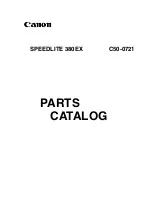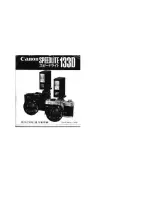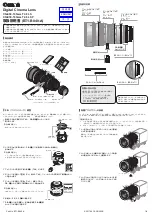
– 5 –
1-2. CP1 CIRCUIT DESCRIPTION
1. Circuit Description
1-1. Digital clamp
The optical black section of the CCD extracts averaged val-
ues from the subsequent data to make the black level of the
CCD output data uniform for each line. The optical black sec-
tion of the CCD averaged value for each line is taken as the
sum of the value for the previous line multiplied by the coeffi-
cient k and the value for the current line multiplied by the
coefficient (k-1).
1-2. Signal processor
1.
γ
correction circuit
This circuit performs (gamma) correction in order to maintain
a linear relationship between the light input to the camera
and the light output from the picture screen.
2. Color generation circuit
This circuit converts the CCD data into RGB signals.
3. Matrix circuit
This circuit generates the Y signals, R-Y signals and B-Y sig-
nals from the RGB signals.
4. Horizontal and vertical aperture circuit
This circuit is used gemerate the aperture signal.
1-3. AE/AWB and AF computing circuit
The AE/AWB carries out computation based on a 256-seg-
ment screen, and the AF carries out computations based on
a 11-segment screen.
1-4. SDRAM controller
This circuit outputs address, RAS, CAS and AS data for con-
trolling the SDRAM. It also refreshes the SDRAM.
1-5. Communication control
1. SIO
This is the interface for the 8-bit microprocessor.
2. PIO/PWM/SIO for LCD
8-bit parallel input and output makes it possible to switch be-
tween individual input/output and PWM input/output. It is pre-
pared for 16-bit parallel output.
1-6. TG/SG
Timing generated for 6 million pixel CCD control.
1-7. Digital encorder
It generates chroma signal from color difference signal.
1-8. JPEG encorder and decorder
It is compressed and elongated the data by JPEG system.
2. Outline of Operation
When the shutter opens, the reset signals and the serial sig-
nals (“take a picture” commands) from the 8-bit microproces-
sor are input to ASIC (IC101) and operation starts. When the
TG/SG drives the CCD, picture data passes through the A/D
and CDS, and is then input to the ASIC as 12-bit data. The
AF, AE, AWB, shutter, and AGC value are computed from this
data, and three exposures are made to obtain the optimum
picture. The data which has already been stored in the SDRAM
is read by the CPU and color generation is carried out. Each
pixel is interpolated from the surrounding data as being ei-
ther R, G and B primary color data to produce R, G and B
data. At this time, correction of the lens distortion which is a
characteristic of wide-angle lenses is carried out. After AWB
and
γ
processing are carried out, a matrix is generated and
aperture correction is carried out for the Y signal, and the
data is then compressed by the JPEG method by (JPEG) and
is then written to card memory (SD card).
When the data is to be output to an external device, it is taken
data from the memory and output via the USB. When played
back on the LCD and monitor, data is transferred from memery
to the SDRAM, and the data elongated by JPEG decorder is
displayed over the SDRAM display area.
3. LCD Block
LCD block is in the CP1 board, and it is constructed by VCOM
generation circuit etc. The video signal from the ASIC are 8-
bit digital signal, and input to LCD directly. It is converted into
RGB signals at driver circuit in the LCD.
The VCOM (common polar voltage: AC) and the R, G and B
signals becomes greater, the display becomes darker; if the
difference in potential is smaller, the element opens and the
LCD become brighter. And also the timing pulse except the
video signal is input to LCD directly from ASIC.
4. Lens drive block
4-1. Shutter drive
The shutter drive signal (SIN1 and SIN2) which is output from
the ASIC is drived the shutter constant level driver (IC951),
and then shutter is opened and closed.
4-2. Iris drive
The iris stepping motor drive signals (IIN1 and IIN2) which
are output from the ASIC (IC101) are used to drive by the
motor driver (IC951).
4-3. Focus drive
The focus stepping motor drive signals (FIN1, FIN2, FIN3 and
FIN4) which are output from the ASIC (IC101) are used to
drive by the motor driver (IC951). Detection of the standard
fo c u s i n g p o s i t i o n s i s c a r r i e d o u t by m e a n s o f t h e
photointerruptor (AFPI) inside the lens block.
4-4. Zoom drive
The zoom DC motor drive signals (ZIN1 and ZIN2) which are
output from the ASIC (IC101) are used to drive by the motor
driver (IC951). Detection of the zoom positions is carried out
by means of photoreflector (ZMPI) inside the lens block.






































